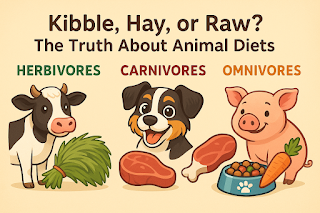Kibble, Hay, or Raw? The Truth About Animal Diets
Animals, whether pets or livestock, have unique nutritional needs that vary by their diet and lifecycle. Here’s a cheeky rundown:
Herbivores: These plant-munching champs (cows, goats, horses) have specialized stomachs for breaking down plants. Their rumen is a busy place, turning grass into energy and, yes, producing some methane as a byproduct. Some (Rabbits) even have some quirky habits like coprophagy—ingestion of the soft, partially digested faecal pellets that are rich in microbial fermentation products directly from the rectum due to fermentation of fibrous material in its hindgut (caeca and colon).
Carnivores: Meat lovers like dogs, cats, and hawks have sharp teeth and short digestive tracts. They need meat not just for fun but for essential nutrients like taurine and arachidonic acid. Think of their diet as the equivalent of a high-protein, no-filler meal plan.
Omnivores: These versatile eaters (pigs, foxes, and chipmunks) enjoy a mix of plants and meat. They’re the ultimate foodies, able to thrive on a variety of diets.
Feeding Your Pets and Livestock
Tailor the diet to their specific needs, and don’t let your lifestyle dictate their menu. Animals require specific diets for health and growth.
Pica Alert
When animals eat non-food items, it’s often due to:
- Nutritional Deficiencies: They might be craving missing nutrients.
- Health Issues: Dental or digestive problems can lead to odd eating habits.
- Stress and Anxiety: New pets, changes, or environmental stressors can disrupt feeding behavior.
- Social and Environmental Factors: Group dynamics and habitat changes can influence what and how they eat.
- Learned Behaviors: Sometimes, animals pick up quirky eating habits from past experiences.
Summary
Understanding and managing the diverse nutritional needs and behaviors of animals ensures they stay happy, healthy, and well-fed. Tailor their diets, and you’ll promote optimal health and longevity, keeping your animals thriving and your farm (or home) running smoothly.Check out previous post - Nutrition: Fueling the Farm and Furry Friends


